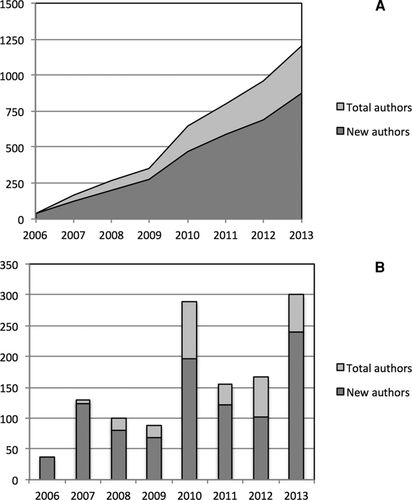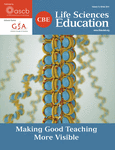Thanks!
In my 2013 editorial, I highlighted several “firsts” experienced by CBE—Life Sciences Education (LSE) and the broader biology education community. I then challenged readers to embark on some additional firsts aimed at encouraging others to make use of evidence-based instruction. This year, I would like to thank everyone for embracing this challenge and continuing to raise the visibility of effective ways to teach and learn biology. All indications are that your efforts, coupled with investment of the American Society for Cell Biology (ASCB), the Howard Hughes Medical Institute, and the Genetics Society of America (GSA), are paying off. LSE is becoming more widely read and recognized.
Thanks to our authors—a group that continues to grow. Analysis of author data from 2006 to 2013 (Figure 1) shows that LSE consistently publishes work from more than 150 authors per year, with greater than 60% being first-time contributors. LSE authors represent a wide range of institution types, including both U.S. and international institutions (Table 1).
Figure 1. Who is publishing in LSE? LSE continues to attract new authors each year. (A) This plot depicts the cumulative number of authors (light gray) who have published in LSE since 2006. The number of new authors (dark gray) reflects whether the particular individual had published in LSE since 2006, when author information was first tracked. Values in later years are more likely to represent truly new authors, because authors in early years could have published before 2006. (B) Since 2010, 150+ authors have published in LSE annually (light gray), with 65–75% of authors being first-time contributors to LSE each year (dark gray). Note: the mathematics and biology and physics and biology special issues were published in 2010 and 2013, respectively. These issues include unusually large numbers of articles.
| Carnegie classification | Number (and percent) of authorship by institution type |
|---|---|
| Research universities (very high research activity according to aggregated and per capita activity) | 553 (41%) |
| Master's colleges and universities | 171 (13%) |
| Baccalaureate | 139 (10%) |
| Research universities (high research activity, high for only aggregated or per capita activity) | 78 (6%) |
| International | 73 (5%) |
| State or federal agency | 53 (4%) |
| Doctoral universities | 40 (3%) |
| Research institute | 21 (1%) |
| Company | 15 (1%) |
| Professional schools (health, engineering) | 14 (1%) |
| Professional society | 13 (1%) |
| Associates | 12 (1%) |
| K–12 schools | 12 (1%) |
| Museum | 7 (0.5%) |
| Other (e.g., foundations, no affiliation, retired) | 125 (9%) |
| Total | 1340 authorships (100%) |
Thanks also to our reviewers. The number of LSE reviewers is also growing and now represents 250+ institutions and five countries. Even with an influx of approximately 50% new reviewers each year, LSE editors and staff continue to receive positive feedback about the constructive nature of reviews, even from authors of manuscripts not selected for publication. In fact, LSE editors and staff regularly receive positive feedback from biologists indicating that the journal publishes work that is approachable to them, in contrast to journals published by and for those formally trained as science education researchers.
Thanks to ASCB and GSA leadership for ensuring that articles published in LSE are increasingly “on the radar” of all biologists. For example, ASCB members receive alerts when each quarterly issue goes live, and each LSE table of contents is published in the ASCB Newsletter. GSA is featuring one LSE article per month in the e-highlights (www.genetics.org/content/198/1/NP.full) of its journal, Genetics. The quality and groundbreaking nature of the work published in LSE is attracting its own attention. For example, work from Eddy and Hogan (2014) was featured in the New York Times (www.nytimes.com/2014/09/03/education/active-learning-study.html?_r=0) and USA Today (http://college.usatoday.com/2014/09/19/struggling-with-lectures-active-courses-may-help). LSE papers have also been featured as “Editors’ Choice” in Science (e.g., Lemons and Lemons, 2013; Hanauer and Dolan, 2014).
Even with all of this progress, teaching strategies that have been shown to be effective are still not widely used. Many faculty members are unaware that these strategies exist and have been shown to be effective (Henderson et al., 2011). Others lack knowledge of how to use this research to improve instruction (Andrews et al., 2011). Institutional and cultural barriers slow or even prevent faculty members from adopting teaching methods demonstrated to be beneficial, precluding widespread employment of effective instructional practices (Brownell and Tanner, 2012). To address this, we need to continue to advocate for evidence-based instruction, as well as publish research that breaks new ground in understanding biology teaching and learning and educational innovations that have been evaluated for efficacy. Thanks to all for your extraordinary efforts to bring everyone under the tent of evidence-based instruction.



